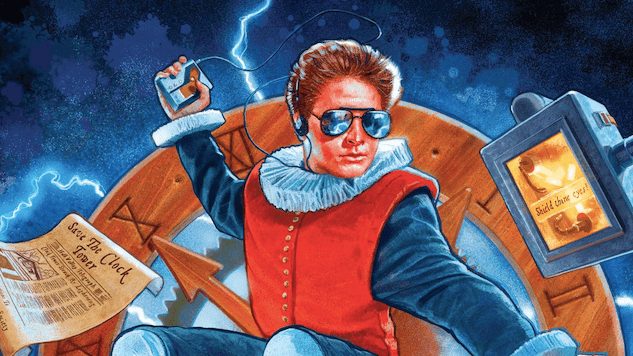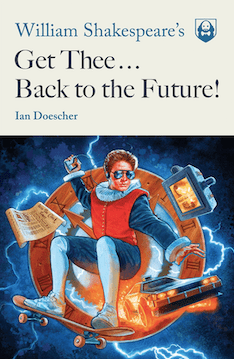Ian Doescher’s Shakespearean Back to the Future Retelling Improves on the Movie
Illustration by Hugh Fleming
“O, call back yesterday, bid time return.”
—William Shakespeare, Richard II
What if Back to the Future no longer seemed stuck in 1985, 2015 or 1885? What if the story really did span time?
With Ian Doescher’s Get Thee Back to the Future!, we’ve gotten as close as humanly possible. Doescher has made a trade of rendering today’s pop culture into Shakespearean plays, starting in 2013 by writing the Star Wars movies in Bardic lingo. With this week’s release of his Back to the Future and Mean Girls adaptations, he’s expanded his series of films-turned-Elizabethan-plays.
It makes sense that Doescher would take cues from William Shakespeare, as the playwright is already unfixed in time. In Julius Caesar, Shakespeare has Brutus say, “Peace! Count the clock.” And Cassius agrees, “The clock has stricken three.” That’s some powerful collective delusion, since clock tech didn’t exist in the Roman Republic. And in Troilus and Cressida, Hector rattles off a nod to Aristotle, a philosopher who wouldn’t be born for a thousand years.
Shakespeare’s a time traveler, just like Back to the Future’s Marty McFly. That’s why the movie works as a weird and wonderful Shakespearean play.
But no matter how clever the adapted version is, our emotional cues remain with the original work. Readers will anticipate iconic scenes, wondering how Doescher will handle Marty’s teenaged mom meeting her son from the future:
In all my childhood hopes and girlish dreams,
Ne’er did I think the angels would deliver
A man unto my house, my room, my bed!
Such riches almost are too much abundance.
Yet I shall manage, for this injur’d youth
Is muscular and shapely, like a Greek,
And I, like Circe, shall give him my welcome.
 We’ll never have an uncomplicated relationship with Shakespeare’s theoretical Back to the Future. And yet, it should be complicated. After all, Doescher’s book is the kind of adaptation Shakespeare spent his career crafting. The bard himself adapted work from a classical giant: Homer. Borrowing, reshaping and rehashing is the name of the game.
We’ll never have an uncomplicated relationship with Shakespeare’s theoretical Back to the Future. And yet, it should be complicated. After all, Doescher’s book is the kind of adaptation Shakespeare spent his career crafting. The bard himself adapted work from a classical giant: Homer. Borrowing, reshaping and rehashing is the name of the game.
Doescher’s Shakespearean Back to the Future even improves on the film; he doesn’t have director Robert Zemeckis’ emotional distance from characters. Marty has passions and angers in the movie, but they’re never considered with Shakespeare’s sensitivity. It’s telling that Doescher delivers a stronger sense of “what Marty is feeling in X scene” than the original filmmaker.
Doescher is imitating Shakespeare, and Shakespeare follows a simple rule: Explain a character’s reaction through dialogue.
Shakespeare didn’t have special effects or grand sets; he had his actors, their costumes and some props. He had to build whole worlds using sentences and asides, all while the pit was hooting for more jigs. That’s what he was up against, and that’s why Doescher’s version of Back to the Future feels more interior and more alive than the original film.
The book is a gimmick, but what a gimmick! It’s a retelling of the recent past that is itself from a more recent past, recounted in the style of someone who ought to be in the distant past—yet it feels madly, beautifully present. The past is prologue, but Get Thee Back to the Future! reminds us that it’s present in every way that matters.







































